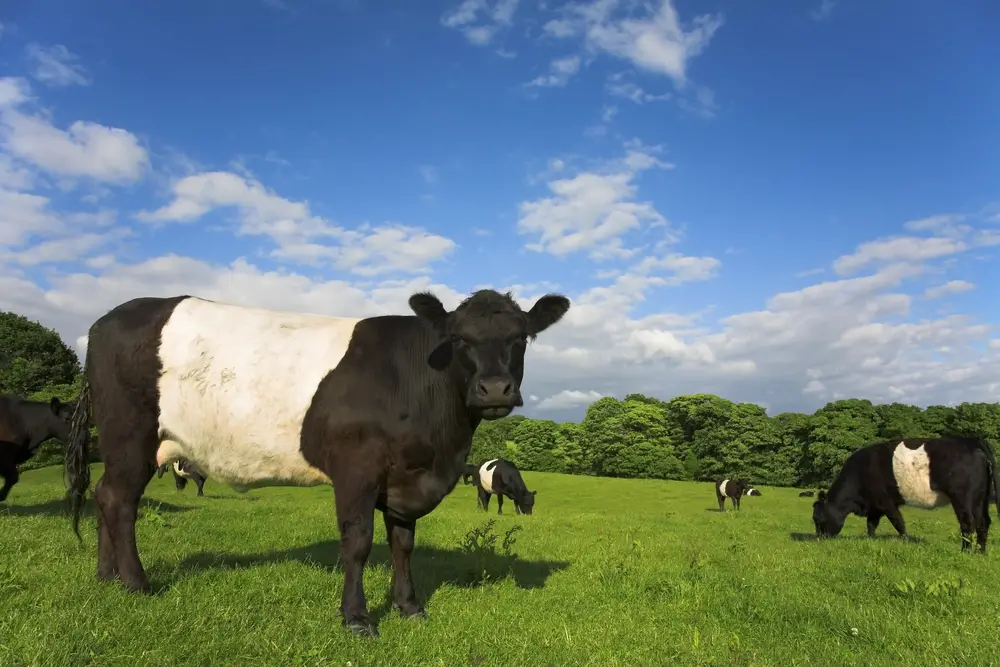Belted Galloway cattle are known as Oreo cows (having been given the nickname after Oreo cookies) and also have the nickname “Beltie” for the white belt around their middle. Scottish Belted Galloway cattle are often confused with Dutch Belted cattle in North America due to a similarity in appearance.
Belted Galloway cattle are an old heritage breed from Scotland with a distinctive black and white belted appearance. Some believe they have been crossed with Dutch Lakenvelder cattle which share a similar appearance.
They are a popular breed of cattle for farms that are located in areas with cold, harsh winters, as Belted Galloway cows are cold-hardy animals that are efficient foragers. They are well-known for the excellent quality of the beef they produce, and are cattle well-suited for beginners due to their ease of handling.
Table of Contents
Where Does Belted Galloway Cattle Come From?
The exact origins of Belted Galloway cattle are not known, but Galloway cattle are a heritage breed from Southwest Scotland that have appeared in literature since the 16th century.
Throughout the late 1700s and early 1800s, Galloways underwent selection for standardization by Scottish breeders as they came in many different colors and were either horned or polled which made it difficult to establish them as their own breed.
Breeders preferred the polled trait and they selected cattle that were able to adapt well to different environments, which over time served to strengthen the breed.
The herdbook for all colors of Galloway cattle was created in 1877, but a separate herdbook was established in 1928 in Scotland for belted cattle, and the different color strains were separated into distinct breeds, with the Belted Galloway being made into its own breed.
Today, Belted Galloway cattle can be found in 23 different countries, and are used primarily as a beef breed. Several breed associations exist for Belted Galloway cattle worldwide.
Breed Associations
- In the United Kingdom, the Belted Galloway Society was established in 1951 to keep registry records of Belted Galloway cattle pedigrees. They also have a breeding program in place to bolster the declining population.
- Belted Galloway cattle were introduced to America in 1951 and the US Belted Galloway Society Inc was the first official US breed association, though the southwestern states created an association of their own called the Southwest Belted Galloway Association.
- In Canada, the Canadian Galloway Association handles registry of all Galloway breeds including Belted Galloways.
- In New Zealand, Belted Galloways have a breed association dedicated to marketing the unique beef characteristics of Belties called the Galloway Cattle Society of New Zealand.
- In Australia, the Belted Galloway Association is responsible for breed registry and promotion and has been in operation since its founding in 1975.
Conservation
Despite the many breed associations worldwide and the continued climb in popularity in the United States, the population of purebreds is falling globally. It is estimated that 26,800 head of Galloway cattle remain worldwide with less than 10,000 of them being Belted Galloways.
There are also less than 2,500 annual registrations for Belted Galloways in the United States.
They are currently on the “Watch” category according to the Livestock Conservancy.
Belted Galloway Cattle Breed Characteristics
| Official Breed Name | Belted Galloway |
| Origin | Scotland |
| Appearance | Can be horned or polled, black with a wide white “belt” around their middle Body conformation is good, with long torso, and strong legs |
| Calf Weight | 71lbs at birth |
| Mature Cow Weight | 1000lbs to 1300lbs |
| Mature Bull Weight | 1600lbs – 2000lbs |
| Ready To Breed | 14 to 18 months |
| Gestation Period | 283 days |
| First Calvings | 2 to 3 years |
| Time to Slaughter | 18 to 27 months |
| Carcass Weight | 550lbs to 800lbs |
| Expected Lifespan | 20 years and productive for 12 to 16 years |
| Known For | Beef production Rough forage efficiency and hardiness Maternal ability and gentle disposition |
| Climate | Excel in cold climates – grows a shaggy coat in winter, and sheds it in summer |

What Is So Special About Belted Galloway Cattle?
Belted Galloway cattle are best known for their exceptional, flavorful lean meat and are primarily a beef breed that is used for specialty beef production.
They have high dressed carcass weight, with more than 60% of live weight yielded. Belted Galloway beef comes with a large rib eye area and a well-marbled carcass with even fat distribution.
As they grow a second coat in winter, they don’t develop the thick back fat layer of other breeds. This makes them one of the more popular grass-fed heritage breed of cattle that is used for high-quality beef.
They are able to be marketed as organic beef and other niche markets as well, and the length and conformation of their body means their carcass yields more high-priced cuts.
Why Should I Raise Belted Galloway Cattle On My Farm?
- Exceptionally hardy breed able to survive in harsh climates
- Grows a double coat of hair which keeps them warm in winter
- Their long hair coat and soft undercoat can be spun into yarn and is prized by spinners
- They shed their long hair in summer, and are able to adapt to warm climates better than other winter-hardy breeds
- Ideal cattle for family farms and country lifestyle
- Extremely efficient grazers and well-suited as grass-fed cattle
- Heritage breed known for exceptional genetic makeup
- Known for docility and ease of handling, making them ideal for beginners
- Good mothering instincts seen in cows
- Heifers have an easier time birthing than other breeds with ease of calving due to low birth weights
- Cows will protect their calves from predation
- Skin useful for production of quality leather goods
- Hide can be used to make attractive rugs and interior furnishings
